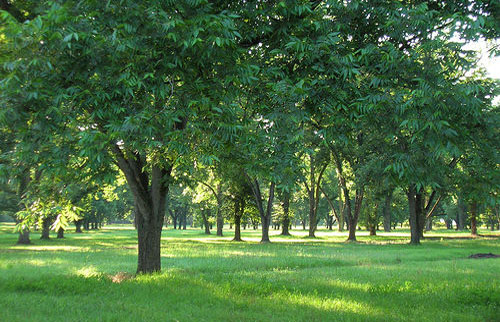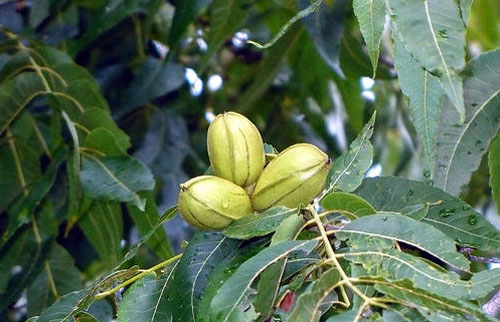Pecan [Carya illinoinensis (Wangenh) K. Koch], is a member of the Juglandaceae family, that includes hickory and walnut. It is the only commercially grown nut crop native to central North America, specifically drainages of the Mississippi River and Mexico. The United States produces 80 to 95% of the world’s pecans from native stands and cultivated orchards of selected cultivars. The most acreage of cultivated (improved) pecan production is in Georgia, with significant cultivation also in the southern tier of states from Alabama to California. Native stands occur from Iowa to the Caribbean Sea near river bottoms and can account for a significant portion of the annual production when prices warrant harvest. In 2014, the United States produced 133,165 tons pf pecans (in-shell) valued at $417,758,000. California's 2500 tons, alued at $10,300,000, represented less than 2% of this domestic product. (USDA 2014)

Although pecan trees have existed in California for more than a century, the first commercial orchard in California was established in the mid 1970s in the Clovis area. Since then, pecan production has spread throughout the central valley, but it is not nearly as widely cultivated as other nut crops (almond, pistachio and walnut) in California.
Pecan trees naturally grow large, 70 to 100 feet tall with a 40 to 75 foot spread and a trunk diameter up to 6 feet. Cultivated trees however, including those grown in California, are generally pruned much smaller in orchard configuration to manage light interception by each tree and optimize production.
Pecan nuts typically require long, hot summers for proper maturation, typical of the current growing areas.

Trees are monoecious (male and female flowers on the same tree). Male flowers are located on 4-5 inch long catkins. Female flowers are small, yellowish-green, and grow on spikes at the tips of shoots. Male and female flowers are dichogamous and mature at different times. Some cultivars are protandrous with male flowers that mature before females, and some are protogynous with female flowers that mature before males. Because pecan is wind pollinated, at least two different cultivars should be planted in close proximity to ensure adequate fruit set (Wells and Conner, 2012). Pecan trees alternate bear, oscillating between heavy and light crop production across years (Vossen and Silver, undated). The degree of alternation can be managed to some extent with proper culture and cultivar selection. Trees can bear fruit for up to 300 years (Gilman and Watson, 1993).
